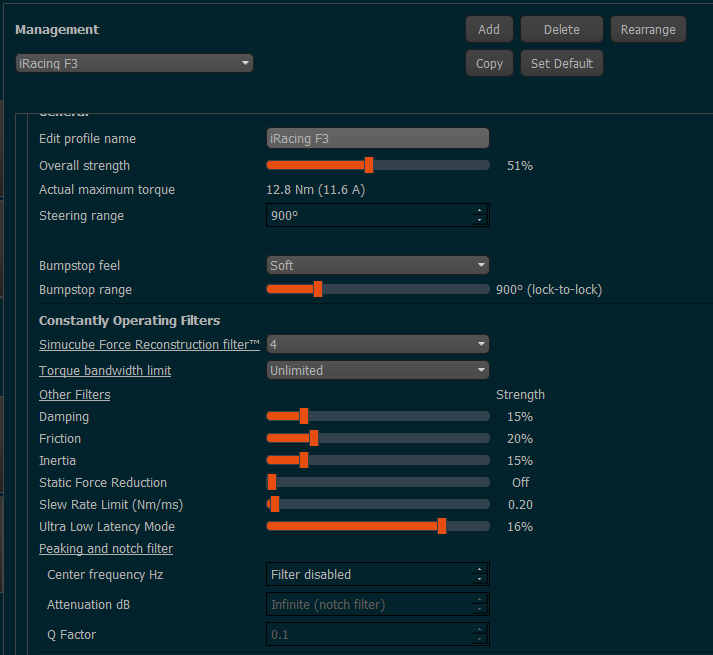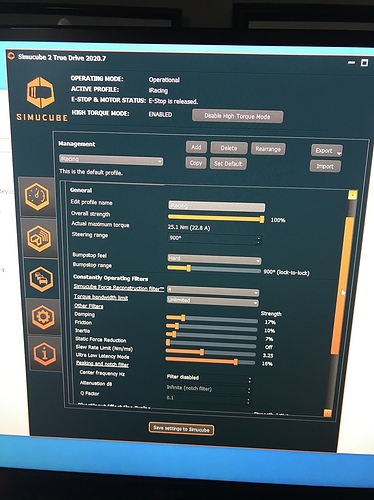just play with the max force slider untill you find what’s comfortable for you.
If it it to hard turning start at maybe 55-60 NM.
Every car and even every setup will feel different,
so as @SuperMonaco_GP said, try it out.
I started at 60 NM 18 month ago.
Now I’m used to it and i prefer higher strength, even i the corners.
if iRacing tweaks in all cars tire temps operating graphics (Or slip angle simulation), people can’t drive beyond this tire limits. But iracing don’t do this because of too much types of wheels in the world and of course amount of drivers in their platform. If they made real tire simulation 100% like in real life, than all their aliens and stars become not too fast, because real life tire simulation need from your driving is good precise in bends, everywhere. I still can’t find the car, sorry tires on any iracing car, where you can fail and going absolutely strait line on low speeds if you overdrive. In real life this is normal situation to fail and go straight because of too fast entry to the corner, without any radius. There is no radius if you going to fast in corner, you just loose your front tires 100% with 100% no grip at all. In all sims you have some cheating radius and this radius increases if your speed is lower.
in Rain conditions this effect is much more visible. That’s why in real racing in rain conditions only really fast drivers can show their talent because there is no cheating engine 
That’s why some people just use low FFB settings in simracing, because they can’t be fast in different way. Because simracing is still simracing because of this… bug? no, this is a feature to hold 100K drivers on platform.
If it’s hard to turn the wheel try to use static force reduction at 10/15%
this only highlights the changes of beanos earlier settings but I can’t find that, if you can please kindly share a screenshot of the full profile with the changed settings.
here you are, beanos initial settings:
Are Beano’s settings pro or Ultimate?
You can use it on both, Joe, it will transfer across and will need small adjustments, if any. I am using very similar settings on my monster SC2 AKM build, it works equally well on smaller and larger servos I’ve found…
But just my POV, it might be different for others…
Thanks Beano,
I picked up an SC2 pro v2 from a local guy recently. This time I get to drive my SC2!!
From 2021 Season 2 - Release Notes [pre-release draft]:
Force Feedback
- A new force limiter has been implemented that reduces force feedback (FFB) generated when a strong vehicle crash or other extreme force event occurs. This system is designed to protect you from your wheel when it generates potentially dangerous levels of force.
-
- A new limiter indicator on the ‘F’ meter illuminates when the limiter is engaged.
-
- By default, this system is enabled. It may be disabled by setting the new “FFBUseForceLimiter=0” within the [Force Feedback] section of the “app.ini” file.
-
- A new telemetry output, “SteeringWheelLimiter” has been added that indicates the force limit percentage being applied.
Source: https://members.iracing.com/jforum/posts/list/3795073.page
This is interesting!
Finally! Full dynamic range without injuries. But lets see how well it works first…
Yes, it’s very welcome, especially in iRacing where you usually had quite weak FFB most of the time which encouraged people to have highest max force in True Drive(25Nm for me) because setting it lower would also scale down weak forces. But on the other hand iRacing had the biggest FFB spikes on collisions so it was far from ideal solution.
Few sims have a solution for that where you can make force output not linear i.e. Assetto Corsa - Gain curve adjustment , AMS 1: low forces boost. And I use it in AMS.
I think someone already asked for adding Gain filter in True precisely because of the iRacing issue. It would be nice feature that other DD wheel software/drivers don’t have(I think) and would be useful in some games, where you’d want to have i.e. low forces boosted.
Other idea is to add a simple slider/filter in TD where you set clipping force - amount of force you want the driver to clip to(by default max force - no clipping), so that beyond that all forces will be clipped. This way you could have max force set to 25Nm or 32Nm so that low forces are strong enough, but in case of accidents(or any other events) the force will be clipped to given value( i.e. 15Nm).
Hello everyone, first of all, absolutely amazing knowledge sharing in this thread. I went to sleep 2AM in the morning cause I just couldn’t stop reading all the technical articles. Really thanks @bsohn for that…
Anyway, I hope I followed the guidance correctly here for setting up my F3 and I would really appreciate your feedback on my settings.
I tested F3 on Nurburgring, as it’s pretty well balanced track - variety of all corner speeds, variety of kerbs heights, big breaking zones, elevation changes… Pretty much perfect track for tweaking imo.
The auto feature recommended Max Force of 29Nm. To allow for spikes I added +3Nm to arrive at 32Nm. The steering heaviness personally felt best at about 0.4 ratio, so in TD I set my wheel strength of SC2Pro at 12.8Nm (12.8/32 = 0.4). I hope that I followed this guidance correctly.
I also played around wit all the other settings (RF, D, F, I,…) and the below is close to optimal settings for me. However, still one thing that bothers me is that the feel of oversteer is veeeery subtle and catching a slide is pretty hard. Like for example the left hander T2 is extremely hard to feel the limit of grip and mostly feels like ice.
Do you have any tips on how to be able to better predict oversteer and feel the grip limit? I know we are talking iceracing, but still I would be happy for every tip that I get.
Thank you very much for your tips and happy racing! 

Everything looks good… as far as the oversteer detection… After you have your wheel set-up and it doesn’t feel as if it is actually imparting handling effects (I.e snapping semi uncontrollably or feeling too heavy to steer the car) then the issues usually come with car set-up as changes.
That being said friction might be a little on the high side to allow for the lightness in the steering to be felt quickly when a car begins to oversteer. Inertia helps counter that a bit but normally only after the moment has happened… As well your Slew rate is set very low… This will limit how fast of a change you can feel in the weight of the wheel… While it smooths things out if there is a quick change in the weight of the wheel it will be mitigated by this setting this can also allow the car to get away from you as you no longer have the sharpness of the movement to tell your brain Wait the car is seeping out… Which is needed in the sim world to a degree as we don’t have the seat of pants feel that we have from a real car… This is also why some people do run toward more activity in the wheel.
Thank you for your tips @bsohn
I always used slew rate as a tool to mitigate sharp peaks in torque caused by going over aggresive kerbs. The value of 0.2 was recommended somewhere in this thread, so I went with it. Now I noticed that while it did the job of smoothing the sudden sharp changes in the feedback, it also caused a lot of detail to be lost along the way. So turning off the slew rate really helped to feel oversteer more.
However, with slew rate completely off I had to turn up Damping in order to mitigate the issue of torque spikes. But then again, I don’t want to overdampen my settings to make all of my inputs dull…So the question is - what is a good tradeoff in slew rate/damping?
Regarding Friction/Inertia - turned both settings down to 5, still really can’t objectively say whether it’s better and whether this resulted in better detail, need to understand correlation between these settings a bit more…I am still pretty new to do this 
Thank you once again for your help.
What is your steering wheel?
Diameter, shape, wheight…
I learned the hard way that you need to match Servo Damping Friction and Inertia to your wheel.
Bigger wheel: -Damping, +Friction, -inertia
Lighter wheels: +Damping, -Friction, +inertia
-Damping never higher than 20% in any scenario
-Friction <5 in a 32cm 1.8kg Porsche wheel, <2 in a 28cm 1.4kg formula rim
-Inertia <3 in the Porsche wheel, <6 in the formula one.
Then, at Racing FFb options, put Wheel Force slider al 1nm and forget about It, just change TrueDrive Overall Forces and iRacing Max Force.
Another tip is to match incar steering with True Drive steering Range. Take an example with F3 car, It has 450° aprox ( dont remember) see that in box turning to the bumpstop. Match that steering Range in TrueDrive and recalibrate on iRacing ( or match the slider manually). This is useful in Cars with less than 540⁰
Ascher F-28. Definitely will try to match that as you say, thank you! Also will the steering range matching.
Then, at Racing FFb options, put Wheel Force slider al 1nm and forget about It, just change TrueDrive Overall Forces and iRacing Max Force.
Here I think already got the Specific Output sorted (~0.43) to my preference so I think is not relevant I think.
It is all a balancing act as such… The thing is to Not try to mitigate the spikes but focus on the other details coming through, you can then adjust the Slew Rate, Reconstruction Filter and TBW to help reduce the feel of those spikes. The reconstruction filter is the only one of these three that will tend NOT to mitigate the signal as TBW is a low pass filter and Slew Rate alters the torque deliver. The Recon filter however tries to smooth the signal to the drive system with minimal alteration to its intended amplitude.
Here are the settings that I use for every car I run I haven’t run the particular car that you are running much at all but the iRacing open wheelers tend to have very spiky feedback in general.
The Wheel Force Slider is irrelevant as long as your Max Force needed is above the number indicated. It is a protection for say you have a 30Nm wheel set to output 30Nm and “auto” says the car you are driving (i.e miata is 15Nm) if you had the wheel force at 1Nm it would change Max force to 15Nm but you are outputting on a 30Nm wheel which has just created an override of 2:1 so you would be getting twice the force you should through the wheel… however if you had the Wheel Strength slider set to 30Nm as the wheel is… “auto” would ONLY go as low as the wheel force or 30Nm even though the miata might have the ability to be lower without clipping… this 30Nm with a 30Nm wheelbase would be 1:!.

